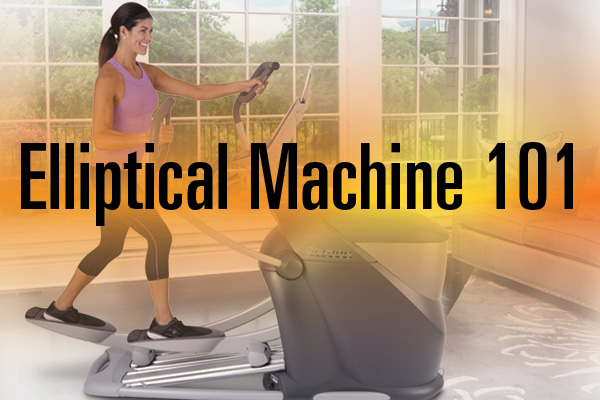
What’s great about most any elliptical machine is that they are very easy to use, and provide effective, low-impact, total-body workouts for everyone from beginners to athletes.
Ellipticals work all the major muscle groups – quadriceps, hamstrings, glutes, hip flexors, core, pectorals, back, shoulders, biceps and triceps – all in one session. And the best part is that while ellipticals challenge you, they don’t beat you up, or leave you with lingering discomfort or pain post-workout.
Plus, for those who tend to do the same workouts – like runners or cyclists – an elliptical machine offers a valuable way to cross train to optimize conditioning but minimize overuse.
High quality elliptical machines are intuitive, with no manual adjustments to make and no learning curve. While it’s tempting to just jump on and go, it’s best to know how to use an elliptical machine properly to maximize your sweat sessions at the health club or at home.
Elliptical Machine 101
First, look over the entire machine, noting the difference between the stationary and moving handlebars. Then grab the stationary handlebars to step onto the elliptical machine and place one foot in each pedal. Stand still for now.
Quickly review the console for programming options and feedback displayed. For the first time you use a specific elliptical machine, it’s easiest to select Quick Start for a Manual program where you simply begin pedaling and manually control the resistance. The machine may ask you to first input your age and weight to help calculate your heart rate targets and caloric expenditure once you get moving.
When you’re ready, hold the stationary handlebars and begin pedaling, making sure to center your weight and distribute it equally over the pedals and keep your toes toward the front lip of the pedal for the most security. Push down and pull through each leg equally, with equal intensity on the downstroke and upstroke. Don’t lock your knees on the downstroke, and lift your heels naturally as you move through the upstroke.
If the motion feels too loose or you can’t control it, increase the resistance level via the button on the console. Notice your hips and try to keep them centered over your feet, without excessive lateral shifting. Keep your tailbone tucked under slightly so you don’t overarch and strain your lower back. Pull your navel toward your spine to engage your core, but don’t hold your breath. Try moving forward and backward for variety and to change the emphasis on different leg muscles.
When you feel comfortable, grip the moving handlebars loosely; don’t clench your hands. The moving handlebars will synch with the movement of the pedals, so this motion should feel natural.
Push and pull with equal intensity, engaging your entire upper body, including your chest and back. Keep the movement smooth and not jerky, and extend your arms fully (without locking your elbows) to use a full range of motion.
If the elliptical machine has Octane’s MultiGrip handlebars, use a variety of grips (overhand, underhand, narrow, wide) to target different muscle groups. And, if your arms fatigue, drop them down to the stationary handlebars at any time for an upper-body break.
As you become familiar with the overall motion, you can alter resistance, speed, incline (on some elliptical machine models) and stride length (again, on select models). This adds variety and challenge to workouts.
Watch the console for feedback on calories burned, distance traveled, time elapsed and heart rate (if available). And take advantage of the variety of programs offered so that you don’t do the same Manual workout every time. You can reap greater results and enjoy more motivation with built-in variety of multiple preprogrammed elliptical machine workouts. Now get going!